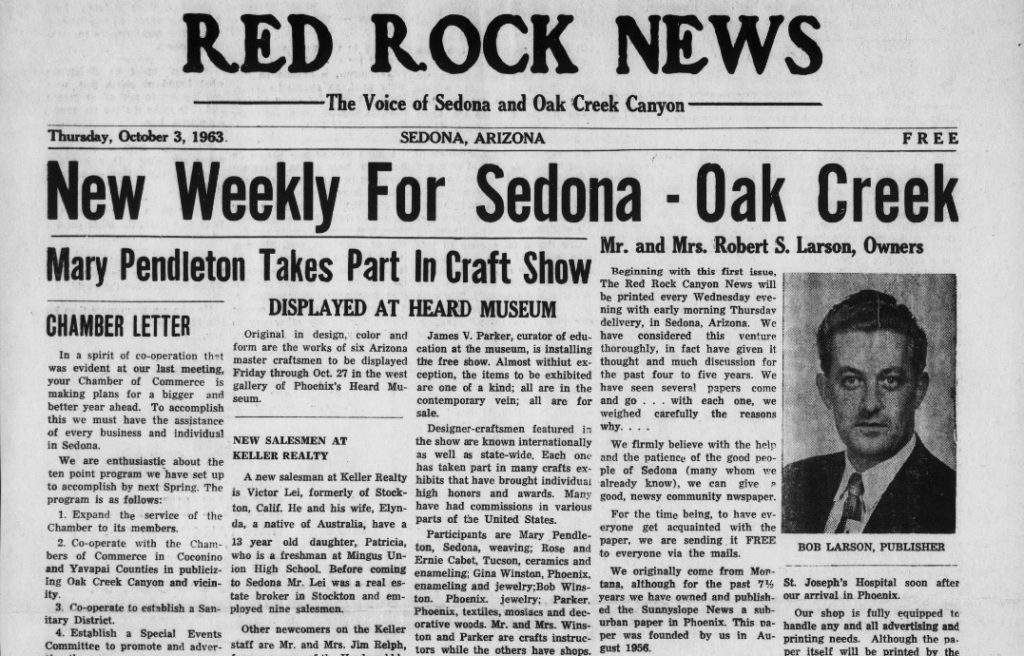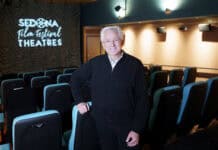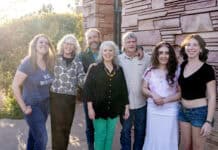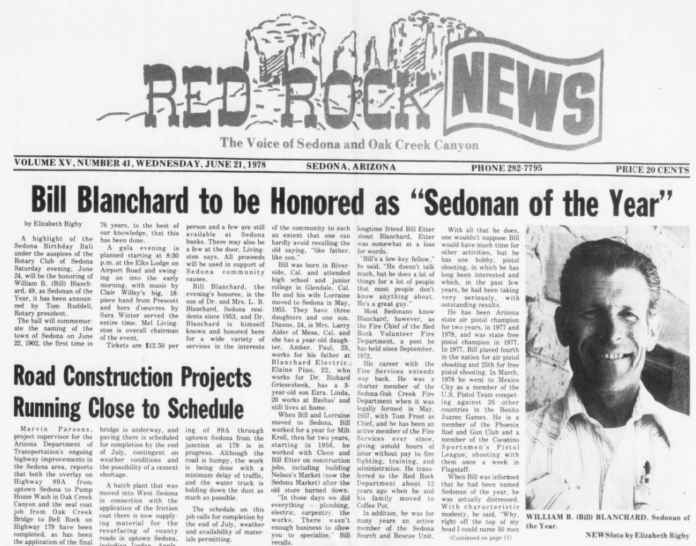Imagine you were looking for information about, let’s say, your grandfather’s barbershop, which he operated in Sedona in the mid-1960s. If you were hoping to start with past issues of the local newspaper, you’d be faced with rolls and rolls of microfiche at the local library. And, this media doesn’t allow for searches by word, so days later you’d still be looking through back issues on the reader.
Now, thanks to a partnership between the Sedona Historical Society and Arizona State Library, Archives and Public Record’s Arizona Memory Project, you can do this research from the comfort of your own home and have the ability to narrow your inquiry with search terms.
Search the Red Rock News from 1963 to 1980: https://azmemory.azlibrary.gov/digital/collection/redrocknews
Search the Sedona Red Rock News from 1980 to 1989: https://azmemory.azlibrary.gov/digital/collection/sdredrocknews
With first-hand experience with this dreaded microfiche, the Sedona Historical Society began two years ago pursuing grants to digitize back issues of the Sedona Red Rock News. The first step was to reach agreement with Larson Newspapers for access and reproduction rights. Next came the work with a specialized vendor to digitize about 800 issues of the paper, scanning over 20,000 pages and creating over 50,000 images in a variety of formats to meet prescribed Library of Congress standards. This was made possible with grants from the Arizona Community Foundation of Sedona and the Arizona Historical Society.
After scanning, the Sedona Historical Society worked with the Arizona Library, Archives and Public Records’ News Content and Digital History staff to get the files onto the state’s Arizona Memory Project website.
The first almost 24 years of past issues of Sedona’s first real newspaper are now available online. The collection of papers are posted on the Arizona Memory Project website and accessible via the museum’s website at sedonamuseum.org/research.
As Sedona grew and more people moved in from other places, there were those who thought the little community might be ready for its own newspaper.
There were several “false starts” by individuals, including the Sedona Spectator in 1958, which shuttered after six months; the Red Rock Arrow that stopped printing after only five months; The Bark mimeographed by the Chamber of Commerce from 1959 through 1960; The Sedonan, which lasted only four months in early 1962 from a man with a political and religious bias that antagonized some; and the Hardscrabble News, founded by two men and their wives with no newspaper experience.
On the heels of those experiments, the Larsons founded a small town newspaper that — finally — grabbed the local audience and prospered.
Robert S. and Loretta Larson had been publishing and editing the Sunnyslope News in Phoenix for more than seven years, often visiting Sedona and wanting to have a paper of their own. The Larsons published their first issue of the Red Rock News in the fall of 1963. That first paper was assembled in the Larson’s home and was eight tabloid pages. One thousand copies were printed and distributed for free to the local population of about 1,200.

The Larsons remembered later that Sedona was slow to accept another newspaper; after all there had been several previous failed attempts. But, Robert was the second generation of a newspapering family and had the experience that those other startups had not. Robert Larson’s father, Ben, was the publisher of the Circle Banner, a weekly newspaper in central Montana. His brothers also ran family-owned newspapers throughout central Montana.
In the beginning, many ads were placed without cash payment, but rather in trade for goods and services. Classified ads were free to the general public — not businesses — and delivery was via U.S. Postal Service.
Dedicated to serving the Sedona community and ascribing to a code of professionalism for independent newspapers, the Larsons’ paper continues to cover local news and stories of interest to Sedona, the Village of Oak Creek and Oak Creek Canyon residents. The paper grew, sometimes to over 32 pages, to report all the happenings in the greater Sedona area.
In the early years, the Larsons had to inconveniently take their layouts to be printed at the Prescott Courier and later the Arizona Daily Sun in Flagstaff. In 1980, they put in their own presses so they could print in town. Other highlights over the last half-century were constant updates to the look and size of the paper, renaming to the Sedona Red Rock News, an increase in the point size of the type to make the paper easier to read, and moving to printing twice a week, which began in 1989.
Today, Robert and Loretta’s children and grandchildren are involved in running this award-winning hometown newspaper, along with printing two additional papers, The Camp Verde Journal and Cottonwood Journal Extra.
Kyle Larson, current general manager and grandson of the founders, is proud of his family’s contributions to the local community as residents, business owners and philanthropists. The family is also excited about the preservation and access these online collections will provide.
“Newspapers report history and local historical societies and museums preserve history,” he said. Larson is also a member of the society’s Board of Trustees.
“This was really a massive collaboration,” Sedona Historical Society Historian Janeen Trevillyan said. “We could not have done the project, let alone have hosted the content in a useable, searchable web-based platform, without the assistance from the state. But, this opportunity was so integral to our mission, we had to pursue it.”
The back issues begin with the first published in 1963 and continue through June 1987. Trevillyan explained that while the Library of Congress and the State of Arizona are digitizing old newspapers, currently they are focusing on pre-1963 editions. It will probably be years before public funding would be available to digitize papers like Sedona’s.
The Arizona Memory Project provides access to the wealth of primary sources in Arizona archives, museums, libraries and other cultural institutions. Visitors to the site will find some of the best examples of government documents, photographs, maps and multimedia that chronicle Arizona’s past and present.
“We wouldn’t have been able to bring this scope of years to the Arizona Memory Project without the partnership and commitment of the Sedona Historical Society, and we hope to be able to partner with other cultural institutions throughout the state in a similar way,“ said Sativa Peterson, News Content Program manager for the State of Arizona Research Library. This Arizona Memory Project is brought to you by the Arizona State Library, Archives and Public Records, a division of the Secretary of State, with funding from a Library Services and Technology Act grant from the Institute of Museum and Library Services.
As holder of a set of the old microfiche and routinely seeing the dread of researchers faced with using the antiquated system for searches, the Sedona Public Library played a support role.
The Sedona Historical Society hopes to find future grants to assist with digitization and continue to make more back issues of the Sedona Red Rock News accessible and searchable.
Ryan Ehrfurth, the state’s Digital History and Maps Librarian manages the Arizona Memory Project and confirmed this is the fourth archival collection to be placed on AMP by the Sedona Historical Society.



















